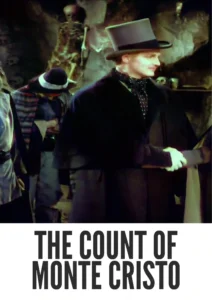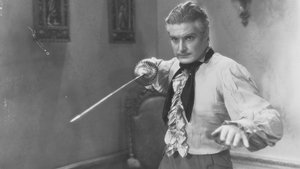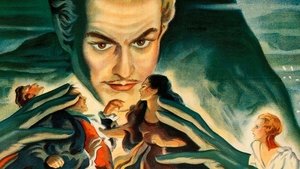Video Sources 0 Views

Synopsis
Revenge, Intrigue, and Color: The Count of Monte Cristo (1934) in Stunning Color

Immerse yourself in the thrilling world of The Count of Monte Cristo, a swashbuckling adventure from 1934, now beautifully colorized for a modern viewing experience. Starring Robert Donat as Edmond Dantès, this film brings Alexandre Dumas’ classic tale of wrongful imprisonment and elaborate revenge to life. Perfect for fans of historical dramas and epic stories, this HD download offers a visually stunning rendition of a beloved literary masterpiece.
The Count of Monte Cristo Storyline: From Imprisonment to Vengeance
The Count of Monte Cristo follows the journey of Edmond Dantès (Robert Donat), a young and promising sailor who is falsely accused of treason and imprisoned in the dreaded Château d’If.After years of unjust confinement, Dantès escapes with the help of a fellow prisoner and gains access to a vast fortune hidden on the island of Monte Cristo. Transformed into the wealthy and enigmatic Count, he embarks on a mission of revenge against those who conspired to ruin his life, including the treacherous Mondego (Sidney Blackmer) and the corrupt Villefort (Louis Calhern). As the Count orchestrates his elaborate plot, he grapples with questions of justice, morality, and the true cost of vengeance. The film culminates in a series of dramatic confrontations, where the Count confronts his enemies and reveals their wicked deeds. Ultimately, The Count of Monte Cristo is a gripping tale of betrayal, resilience, and the pursuit of justice.
Movie Cast
The film boasts a talented cast of actors who bring the characters to life:
- Robert Donat as Edmond Dantès/The Count of Monte Cristo
- Elissa Landi as Mercédès de Villefort
- Louis Calhern as Raymond de Villefort
- Sidney Blackmer as Fernand Mondego
- Raymond Walburn as Danglars
Movie Genre
The Count of Monte Cristo falls into the genre of swashbuckling adventure, with elements of historical drama and romance. Its epic scope, thrilling action sequences, and timeless themes make it a captivating and enduring film.
Historical Context: A Classic Adaptation
Released in 1934, The Count of Monte Cristo is considered one of the best early screen adaptations of Alexandre Dumas’ famous novel. Produced during the Golden Age of Hollywood, the film showcases the studio’s commitment to quality storytelling, lavish production values, and strong performances. While there have been numerous adaptations of the novel over the years, this version remains a benchmark for its faithful depiction of the source material and its engaging cinematic presentation.
Colorization Details
This colorized version of The Count of Monte Cristo has been meticulously restored using modern digital techniques, enhancing the visual appeal while preserving the film’s original atmosphere. The colorization process involved carefully analyzing the grayscale tones of the original black and white footage and assigning appropriate colors to each scene. While the specific software used remains proprietary, the techniques employed included advanced algorithms for color palette selection and image enhancement. This painstaking process brings new life to the characters and settings, making the story even more engaging for modern audiences. While some may debate the merits of colorizing classic films, it introduces these films to a broader audience, ensuring their legacy for future generations.
Technical Details
- Director: Rowland V. Lee
- Screenplay: Rowland V. Lee, Dan Totheroh, Philip Dunne
- Based on: the novel by Alexandre Dumas
- Cinematography: Gregg Toland
- Edited by: Grant Whytock
- Production Company: Reliance Pictures
- Distributed by: United Artists
- Runtime: 113 minutes
Technical Specifications
- Download Format: MP4
- Resolution: HD (1080p)
- Compatibility: Compatible with most devices, including smartphones, tablets, computers, and smart TVs.
Reviews and Critical Reception
The Count of Monte Cristo (1934) is widely regarded as a classic adventure film, praised for its compelling story, strong performances, and impressive production values. It remains a beloved adaptation of Alexandre Dumas’ novel and a testament to the enduring appeal of classic Hollywood cinema. As a timeless tale of revenge and redemption, The Count of Monte Cristo continues to captivate audiences with its thrilling plot and memorable characters.
FAQs
- Q: What is The Count of Monte Cristo about?
- A: The Count of Monte Cristo is about a man who is wrongly imprisoned and seeks revenge on those who betrayed him.
- Q: Is this version of The Count of Monte Cristo colorized?
- A: Yes, this version has been professionally colorized to enhance the viewing experience.
- Q: What makes this adaptation of The Count of Monte Cristo special?
- A: This 1934 adaptation is considered one of the best early screen versions of Alexandre Dumas’ novel, known for its strong performances and faithful depiction of the source material.
- Q: What is the download format?
- A: The download format is MP4, which is compatible with most devices.
- Q: What resolution is the download?
- A: The resolution is HD (1080p), providing a high-quality viewing experience.
Download Now in HD!
Watch The Count of Monte Cristo Today!













